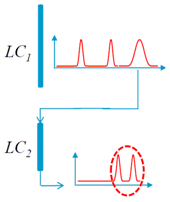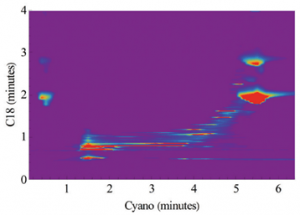How can 2-Dimensional (2D) chromatography help solve challenging HPLC separations and quantitation?
High Performance Liquid Chromatography (HPLC) has been an indispensable tool for analytical chemists for more than 40 years. It has helped with the separation and quantitation of trace level organic compounds in countless complex matrices due to various separation mechanisms (reverse phase and normal phase for example), numerous detector options (ELSD, RI, UV, Corona CAD) and others.
We’ve known HPLC to be used with a single column in most applications. But what about using two columns – with very different stationary phases?
Enter 2D HPLC: A way to dramatically increase separating power by injecting the effluent (or a part of the effluent) from one column onto a second column. In most cases, the second column will have complementary separation behavior.
There are two basic ways to perform 2D HPLC: Comprehensive 2D HPLC (or LCxLC) and Heart-cutting 2D HPLC (or LC-LC)
With LCxLC, the complete eluent of the first column is injected onto the second column. The peaks are reconstructed in a 2D manner as the following:
- LC1 = separation of first HPLC column
- LC2 = separation of second HPLC columnBaseline resolution of the broad, third LC1 peak is achieved with the LC2 column.
With LC-LC, a specific peak (or retention time range) from the first HPLC column is selected for a secondary separation on LC2. Compared with LCxLC, it is possible to achieve greater separation for a specific peak as the LC2  column can be selected to maximize separation efficiency for a specific peak in LC1 (e.g., a longer column).
column can be selected to maximize separation efficiency for a specific peak in LC1 (e.g., a longer column).
Okay…what’s so great about 2D HPLC?
Firstly, 2D HPLC can be a “go to” method to eliminate time-consuming and costly sample preparation steps. This can be extremely valuable for a chemist when faced with the extremely difficult task of quantitation of trace level organic compounds in a complex matrix.
2D HPLC can also be used to monitor small changes in complex mixtures. This is accomplished by evaluating 2D maps of samples (see below).
Overall, 2D HPLC can be a fully automated process and method development is greatly expedited with powerful software.





